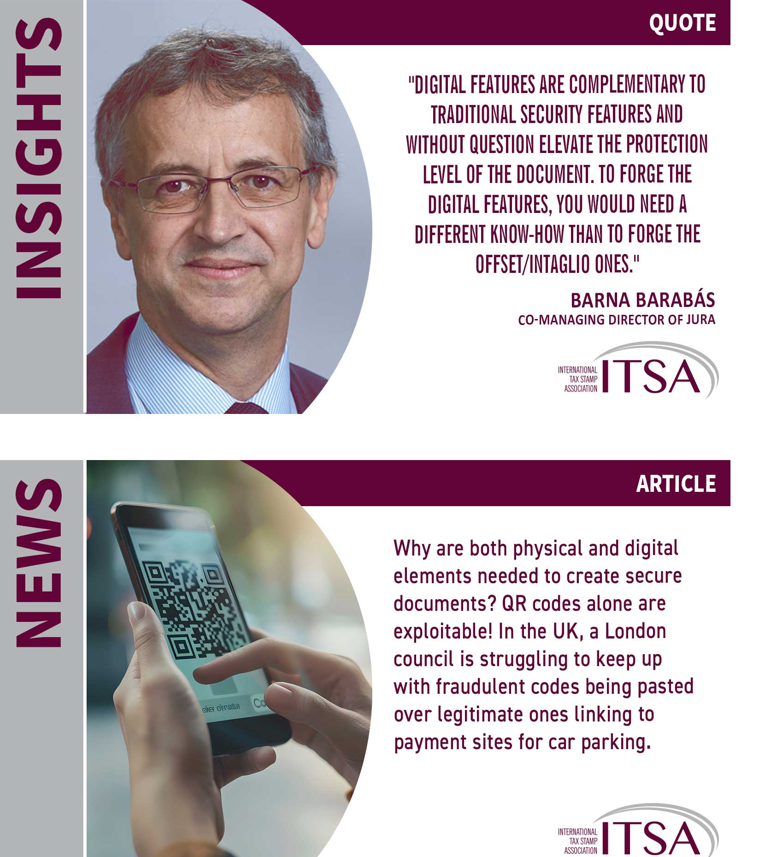Combining physical and digital elements on tax stamps ensures that the strengths of both are exploited, and the weaknesses of each are covered. The International Tax Stamp Association (ITSA) is pleased to announce the launch of a social media campaign examining the topic in depth, featuring quotes from industry insiders and stories from around the world that demonstrate the strength of a ‘phygital’ approach.
ITSA is active on LinkedIn and X (formerly Twitter), posting twice a week on the latest news and insights from the world of tax stamps and excise. You can find ITSA posts on LinkedIn at www.linkedin.com/ company/taxstamps and on X @TaxStamp.
We encourage all our readers to follow and engage with ITSA on their platform of choice!
Any security measure – however sophisticated – will have advantages and limitations. Simply put, using both physical and digital features on tax stamps gives the broadest range of advantages while minimising limitations, and opportunities for counterfeiters.
Visible physical features include optical effects, holograms, microtext, and tamper-evident elements, and they’re the frontline defence against forgeries. Hard to replicate, easy to identify visually without special equipment, they enable anyone in the value chain –including consumers – to conduct a quick check for any missing or suspicious features.
As visible features provide the first line of defence, so covert physical features, such as taggants and forensic elements, provide unequivocal proof of authenticity, as a last line of defence, in cases where there is doubt as to the genuineness of a document or product.
One limitation of physical features, though, is that they don’t offer great traceability, since they don’t readily record and feed data into online systems.
Digital technologies, meanwhile, are complementary features that enhance security and add track and trace and real- time production monitoring functionality. QR codes, for example, take up a small amount of real estate on a tax stamp, but hold vast amounts of data that can be scanned to provide information on an item’s provenance, such as where it came from, how it travelled, and when and how tax was paid.
However, the disadvantage of these technologies is that they require special equipment and system access to verify, meaning some stakeholders are less able to engage with them.
But if we bring these digital and physical features together, we have a solution that provides the most robust defence against illicit trade, with the physical features offering on-the-spot verification by experts and non-experts alike, and the digital features introducing greater track and traceability.
But... not everyone thinks like that. In fact, the tides of change seem to be on a course towards an ever-digital future, where physical features are relegated to the status of optional ‘add-on’. This relentless move towards everything digital is reflected in government-led regulations and initiatives such as the EU Digital Product Passport, EU Tobacco Products Directive, and the global FCTC Protocol to Eliminate Illicit Trade in Tobacco Products, which focus primarily on digital traceability systems.
In the private sector as well, many brand owners, online retail stores and other supply chain actors are implementing QR codes on products as a way for stakeholders to authenticate the products as genuine... even though these codes often lack any physical security features to differentiate them from fakes.
Companies with security at their core, such as the 28 members of ITSA, therefore have a responsibility to sound the alarm, by raising awareness around the dangers of using purely digital solutions to authenticate and trace products.
These companies, in advocating for a robust, phygital combination, recognise the value they can bring to the ‘brave, new digital world’, and have transformed themselves accordingly. Even state security printers, traditionally known for producing banknotes, coins, and secure documents, are repositioning themselves as providers of integrated authentication and traceability systems that combine services such as blockchain-based ID platforms and digital certification technology, with physical security solutions.

ITSA’s new campaign will consist of two posts per month, one highlighting a quote from an industry expert on the value of phygital, and the other featuring a story about the risks of relying solely on one security approach – typically digital – and the rewards of combining both.
Follow ITSA on LinkedIn or X to watch the campaign unfold and have your say!